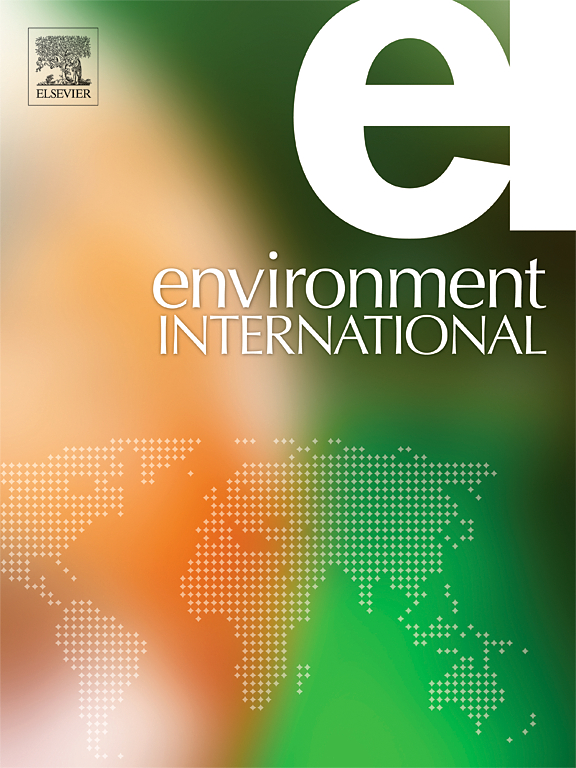Microplastics and nanoplastics co-exposure modulates chromium bioaccumulation and physiological responses in rats
IF 10.3
1区 环境科学与生态学
Q1 ENVIRONMENTAL SCIENCES
引用次数: 0
Abstract
The environmental fragmentation of plastics generates a mixture of plastic particles of various sizes, which frequently co-occur with other mobile and persistent environmental pollutants. Despite the prevalence of such scenarios, the interaction between micro- and nanoplastics (MNPs) and their combined effects with environmental pollutants, such as highly toxic hexavalent chromium (Cr(VI)), remain almost entirely unexplored in mammalian species. This study demonstrated that nanoplastic and microplastic particles co-aggregate and together influence Cr bioaccumulation patterns and related physiological alterations in rats. Following a four-week repeated intragastric exposure of Wistar rats to MNPs and Cr(VI), either alone or in combination, MNPs significantly enhanced Cr bioaccumulation in the liver, heart, brain, and skin. Under co-exposure conditions, Cr(VI) was the primary driver of cellular effects observed in the blood, including shifts in immune cell subpopulations (e.g., neutrophils, lymphocytes) and alterations in red blood cell indices, while serum biochemistry reflected limited physiological stress. MNPs per se decreased creatine kinase activity and increased cholesterol levels. In summary, polystyrene MNPs increase Cr(VI) distribution and bioavailability, but co-exposure does not uniformly exacerbate toxicity. Instead, their interaction may selectively alter physiological responses, emphasizing the need for a deeper understanding of their combined effects and potential health risks.


z 微塑料和纳米塑料共同暴露可调节大鼠体内铬的生物累积和生理反应
塑料在环境中的破碎产生了各种大小的塑料颗粒混合物,这些颗粒经常与其他流动和持久的环境污染物共存。尽管这种情况普遍存在,但微塑料和纳米塑料(MNPs)之间的相互作用及其与环境污染物(如剧毒六价铬(Cr(VI)))的综合效应在哺乳动物物种中几乎完全未被探索。本研究表明,纳米塑料和微塑料颗粒共同聚集并共同影响大鼠体内Cr的生物积累模式和相关生理变化。Wistar大鼠单独或联合暴露于MNPs和Cr(VI) 4周后,MNPs显著增强了Cr在肝脏、心脏、大脑和皮肤中的生物积累。在共暴露条件下,Cr(VI)是血液中观察到的细胞效应的主要驱动因素,包括免疫细胞亚群(如中性粒细胞、淋巴细胞)的变化和红细胞指数的改变,而血清生化反应则反映了有限的生理应激。MNPs本身降低了肌酸激酶活性并增加了胆固醇水平。综上所述,聚苯乙烯MNPs增加了Cr(VI)的分布和生物利用度,但共同暴露并不均匀地加剧毒性。相反,它们的相互作用可能选择性地改变生理反应,强调需要更深入地了解它们的综合影响和潜在的健康风险。
本文章由计算机程序翻译,如有差异,请以英文原文为准。
求助全文
约1分钟内获得全文
求助全文
来源期刊

Environment International
环境科学-环境科学
CiteScore
21.90
自引率
3.40%
发文量
734
审稿时长
2.8 months
期刊介绍:
Environmental Health publishes manuscripts focusing on critical aspects of environmental and occupational medicine, including studies in toxicology and epidemiology, to illuminate the human health implications of exposure to environmental hazards. The journal adopts an open-access model and practices open peer review.
It caters to scientists and practitioners across all environmental science domains, directly or indirectly impacting human health and well-being. With a commitment to enhancing the prevention of environmentally-related health risks, Environmental Health serves as a public health journal for the community and scientists engaged in matters of public health significance concerning the environment.
 求助内容:
求助内容: 应助结果提醒方式:
应助结果提醒方式:


